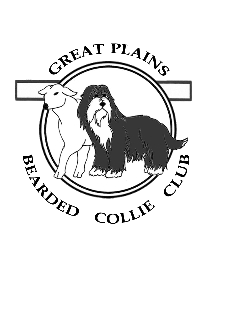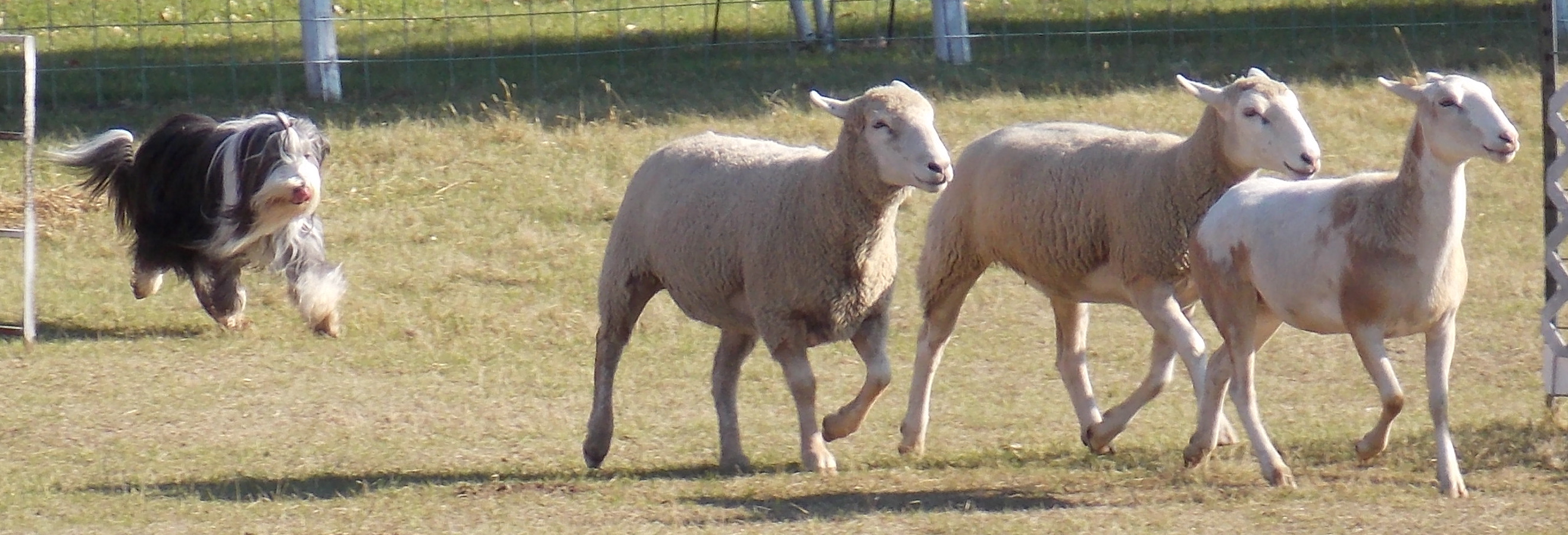 Great Plains Bearded Collie Club
Great Plains Bearded Collie Club

Reflections From the Field
Brian Wistrom, AKC certified herding judge
Our BCCA Herding Chair, Elsa Sell asked if I would submit an article from my perspective as a herding judge. What follows is related primarily to trialing in the AKC A course, but can also hold true for other courses and venues.
The Instinct Test (HIC): There is nothing more thrilling than to see a Beardie turn on to sheep, rounding them up and moving them around the ring. At this level I look for the dog to demonstrate an interest in moving the stock, as well as the ability to change direction (go both ways around the stock), regroup the stock as necessary, and come away from the stock when called. It is always helpful to expose your dog to stock before attempting the instinct test. If the test does not go well, i.e. the dog is unwilling to participate, don’t be discouraged. Herding instinct doesn't always click in right away. Maturity and continual exposure to stock can make a huge difference. Instinct testing can be done at any age.
Herding Test (HT): At the beginning AKC test level handlers can find managing the sheep, the dog and the line of travel a challenge. Ideally, you have trained to the point of working calmly with your dog and have a solid sit, stay, and recall off the sheep. Situations like the dog splitting the sheep, or continually circling the sheep, or moving sheep into the fence corner are common occurrences. At the Herding Test level I look for a controlled pause at the beginning of the run followed by three passes up and down the field at or near the cone on each end of the field. The run ends with a recall off the sheep. There is a lot to keep track of at the HT level and for the beginning handler, it can be very confusing. Where are the sheep? Where am I on the course? How can I keep my dog under control? My advice on how to approach this task is to keep your eyes and your self with the stock. This will take pressure off the dog who can then focus on the stock. The stock will tell you where your dog is by how they react. If the stock split, walk to where the larger group gather and bring them to the smaller group. Remember to keep walking, lead the way.
Pre-Trial Test (PT): Timing, control, and the ability to pen the sheep is required at this level. Again, I look for a controlled pause at the beginning of the run before gathering the stock and walking the course. The PT course takes you behind two obstacles one direction, continuing half way down the other side of the field and than retracing your steps, again passing behind those same two obstacles. Somewhere along the course I need to see you have a stop, which means you, the stock, and your dog are not moving. At the end of the run you need to be able to re–pen the sheep. The dog does not need to hold them off the gate but does need to allow them to exit the field. Again the best advice I can give is to stay with the sheep, if they split go to the largest group and bring them to the smaller group. You should be leading the route on the course.
Started Level: The Started course is the beginning level of the trialing courses. At this level you still have a lot of physical influence on the stock. However your dog needs to show more control and some independent thinking on how to manage the stock. In the Started classes the handler has the ability to help the dog through most situations. A dog needs to display some understanding of what is required, i.e. to bring the handler the stock in a fairly calm manner.
A lot of times at the beginning of the run, the stock may not settle perfectly at the set-out point. They may have already read the excitement from the dog and are not willing to settle. If this happens, the judge may call for a different set of stock. To start the run, it may be best to send your dog as soon as the stock are near the set-out point. Once the outrun and lift are complete and the stock pass the horizontal A line that extends across the field, you have the ability to go to the stock anywhere on the field to help regain control of the situation. This means that if the stock split and go different directions, head to where the majority of the stock gather (two if a group of three or three if a group of five). Don't expect your dog to recover the split all by itself. It is extremely difficult for you or your dog to bring one back to the two or two to the five. Always take the majority to the minority. Once recovered, bring them back to where they escaped from and continue the course. This holds true throughout the course, whether A or B. As you work your way around the field remember not to go through any of the obstacles. You can stand at the mouth of an obstacle to help bring the stock, but only the stock and dog can move through them. The exception is the cross-drive panels on the way between the number 4 and number 5 markers.
If you are trialing at the started level on B course you are allowed to walk through the panels.
Intermediate Level: The transition to the Intermediate level is probably the most difficult to achieve. Your dog has to work more independently, responding to your vocal, hand and body gestures, or whistle commands, as well as use it's own initiative. As the handler you are more restricted where and when you can move. Add to that, you now have to pen the sheep in the middle of the field and get them back out of the pen in a controlled manner. I have observed a lot of handlers who are unsure of where the handler’s zone is and are confused as to when they can leave it. My advice-study the Herding Regulations Book and be sure to ask questions in the handlers meeting.
Advance Level: In the Advanced level the dog has to work independently and the handler has limited opportunity to help. Again, only voice, gesture, or whistle commands can be used to direct the dog where you want the stock to go. I have noticed some handlers forget to leave the handlers post once the stock have crossed the diagonal line that extends between the handlers post and the number three marker. Remember that a handler does not get extra credit for the dog penning the stock at the hold/exam pen by itself; you can help the dog. You don't have to run over to the pen, but you should be leaving the post. I look for an attempt at driving the stock to the number four before attempting the cross-drive to the five.
As far as B course is concerned the handler restrictions are similar to A course at all levels. What I like about trialing the B course, as well as judging it, is the openness of the course. There is less pressure exerted on the stock and dog; both seem to relax while working. There is a longer outrun and distances between obstacles greater, but to me this course seems to be a more natural work situation.
In general, competing in a trial, it is best to center on accomplishing one task at a time. In other words, first get to the proper location to start the run, wait for the stock to get into the field and possibly to set, then send the dog on the outrun, lift, and fetch.
Always watch the stock.A handler can tell where the dog is by how the sheep are reacting. Focusing on the stock instead of the dog takes pressure off the dog, so the dog starts watching the stock instead of the handler. Commands should always relate to what the stock are doing.
At all levels be careful how you use the stock stick. It can send confusing messages to your dog, as well as being interpreted by the judge as threatening the dog.
As hard as it can be, try to keep your emotions out of the run.
Study the course requirements for the level you enter. You do not need to start trialing at the lower levels in AKC. Some folks wait until their dog is at the Advanced level before they enter any trials. However, if you have a qualifying run at specific level, you are unable to enter future trials at a lower level on that course/stock.
Watch earlier runs to learn how the stock are reacting that day. Wind, temperature, previous days experiences, etc., can have a profound effect on their disposition. If the stock aren't settling at the set out point it may be best to send your dog on it's outrun before they arrive there.
Ask questions at the handlers meetings. Ask for clarification if you don't understand what the Judge is saying. Don't be afraid to refer to the AKC regulations if what they're saying doesn't sound correct.
Most of all have fun. Herding is not easy. There are always new challenges to contend with.
In closing, for me the most rewarding aspect of trialing or working with my dogs is the partnership that develops between us. Whether I successfully complete a run or not, I am doing it together with my dog and that bond is unbeatable.